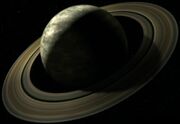mNo edit summary |
No edit summary |
||
| Line 6: | Line 6: | ||
In [[2371]], the {{USS|Voyager}} found a ringed planet in the [[Delta Quadrant]] which was also class D. Some of the asteroids comprising the rings were big enough to have [[class M]] environments inside them. ({{VOY|Emanations}}) |
In [[2371]], the {{USS|Voyager}} found a ringed planet in the [[Delta Quadrant]] which was also class D. Some of the asteroids comprising the rings were big enough to have [[class M]] environments inside them. ({{VOY|Emanations}}) |
||
| − | A [[subspace sinkhole]] encountered by the ''Voyager'' in [[2375]] led to a [[subspace]] pocket, where a [[star system]] |
+ | A [[subspace sinkhole]] encountered by the ''Voyager'' in [[2375]] led to a [[subspace]] pocket, where a [[star system]] composed of a [[G-type star]] and three planets was located. One of these planets was class D. It was described as hot, arid, and rocky. ({{VOY|Gravity}}) |
{{Planetary classification}} |
{{Planetary classification}} |
||
Revision as of 17:58, 18 October 2013

A ringed class D planet
In the Federation standard system of planetary classification, a class D planet was characterized as a small, rock-based body, such as an asteroid, moon or other barren, cratered planetoid with little or no atmosphere.
The planet known as Weytahn to the Andorians and Paan Mokar to Vulcans is an example of a class D world. Weytahn was class D before terraforming. It was described as being not much larger than Earth's moon. (ENT: "Cease Fire") Regula, which was described as a "great rock in space" with a few "unremarkable ores," was also a class D planet. (Star Trek II: The Wrath of Khan)
In 2371, the USS Voyager found a ringed planet in the Delta Quadrant which was also class D. Some of the asteroids comprising the rings were big enough to have class M environments inside them. (VOY: "Emanations")
A subspace sinkhole encountered by the Voyager in 2375 led to a subspace pocket, where a star system composed of a G-type star and three planets was located. One of these planets was class D. It was described as hot, arid, and rocky. (VOY: "Gravity")
| Planetary classification |
|---|
| B • D • G • H • J • K • L • M • N • R • T • Y • Other classes |
Appendices
Background
According to Star Trek: Star Charts, on page 23, a Class D world had an average age of two to ten billion years, had a diameter of 100 to 1,000 km, could be found in every zone of a star system, could be found in greater numbers around larger planets or in asteroid belts, had a barren and cratered surface, and had little to no atmosphere. An example given of a Class D world was Luna.
External link
- Template:NCwiki
